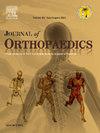全髋关节置换术中骨水泥与抛光假体间摩擦系数对假体沉降的影响
IF 1.5
Q3 ORTHOPEDICS
引用次数: 0
摘要
采用非线性有限元分析方法研究了全髋关节置换术中骨水泥与磨光假体之间的摩擦系数对假体沉降的影响。管柱沉降是由管柱滑移和水泥剪切变形共同作用的结果。侧边沉降主要由干滑引起,侧边沉降主要由水泥变形引起。在摩擦系数较低的情况下,载荷释放后发生“反向沉降”,杆向上移动,压应力传递给水泥。另一方面,摩擦系数越高,水泥地幔剪切变形越明显,残余应变在近端区域积累。目前的研究表明了一种权衡关系:高摩擦增加近端假体周围骨折(PPFs)的风险,而低摩擦增加远端假体周围骨折的风险。本文章由计算机程序翻译,如有差异,请以英文原文为准。
Effect of the friction coefficient between bone cement and polished stem on subsidence of the stem in total hip arthroplasty
The effect of the friction coefficient between bone cement and polished stems on stem subsidence was investigated in total hip arthroplasty (THA) using nonlinear finite element analysis. Stem subsidence results from both stem slip and shear deformation of the cement. On the lateral side, subsidence is mainly caused by stem slip, while on the medial side, cement deformation is involved. With low friction coefficients, "Reverse subsidence" occurs after load release, where the stem moves upward, and compressive stress is transmitted to the cement. On the other hand, with high friction coefficients, more significant shear deformation of the cement mantle occurs, and residual strain accumulates in the proximal region. The present study implies a trade-off relationship: high friction increases the risk of periprosthetic fractures (PPFs) in the proximal region, while low friction increases the risk in the distal region.
求助全文
通过发布文献求助,成功后即可免费获取论文全文。
去求助
来源期刊

Journal of orthopaedics
ORTHOPEDICS-
CiteScore
3.50
自引率
6.70%
发文量
202
审稿时长
56 days
期刊介绍:
Journal of Orthopaedics aims to be a leading journal in orthopaedics and contribute towards the improvement of quality of orthopedic health care. The journal publishes original research work and review articles related to different aspects of orthopaedics including Arthroplasty, Arthroscopy, Sports Medicine, Trauma, Spine and Spinal deformities, Pediatric orthopaedics, limb reconstruction procedures, hand surgery, and orthopaedic oncology. It also publishes articles on continuing education, health-related information, case reports and letters to the editor. It is requested to note that the journal has an international readership and all submissions should be aimed at specifying something about the setting in which the work was conducted. Authors must also provide any specific reasons for the research and also provide an elaborate description of the results.
 求助内容:
求助内容: 应助结果提醒方式:
应助结果提醒方式:


